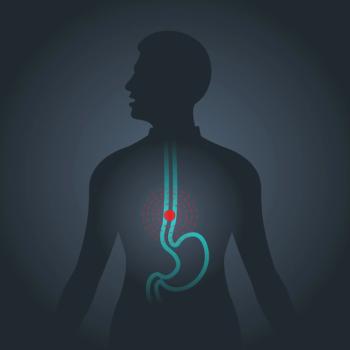
- ONCOLOGY Vol 14 No 10
- Volume 14
- Issue 10
UFT/Leucovorin vs 5-FU/Leucovorin in Colon Cancer
Adjuvant chemotherapy has been shown to alter the natural history of resected colon cancer. Two regimens (fluorouracil [5-FU] plus leucovorin and 5-FU plus levamisole) have been found to prolong disease-free survival and overall survival in affected patients.
ABSTRACT: Adjuvant chemotherapy has been shown to alter the natural history of resected colon cancer. Two regimens (fluorouracil [5-FU] plus leucovorin and 5-FU plus levamisole) have been found to prolong disease-free survival and overall survival in affected patients. Previous comparisons of these two regimens indicate that 5-FU plus leucovorin may offer a small disease-free survival and overall survival advantage. Evidence that UFT (uracil and tegafur) plus oral leucovorin is associated with significant antitumor activity and has an acceptable toxicity profile makes this a logical formulation for the adjuvant treatment of colon cancer. The National Surgical Adjuvant Breast and Bowel Project Protocol C-06 is a randomized comparison of the relative efficacies of 5-FU plus leucovorin vs UFT plus leucovorin. Preliminary analysis of the toxicity findings among 1,530 evaluable patients indicates that both regimens are well tolerated and have similar toxicity profiles. [ONCOLOGY 14(Suppl 9):24-27, 2000]
The combination of uracil and tegafur (UFT) in a 4:1 molar concentration was developed by Fujii et al.[1] Tegafur is a 5-fluorouracil (5-FU) prodrug and uracil competes with 5-FU as a substrate for dihydropyrimidine dehydrogenase, an enzyme that enhances the catabolism of 5-FU. In preclinical studies, the coadministration of uracil with tegafur enhanced concentration of 5-FU in tumors and increased antineoplastic activity.[2-6] Phase I and II trials in patients with advanced cancer and metastatic colon cancer indicate that UFT administered orally with the biochemical modulator leucovorin for more than 28 days resulted in response rates of 25% to 43% and a toxicity profile acceptable for the adjuvant setting.[7-9]
The National Surgical Adjuvant Breast and Bowel Project (NSABP) has undertaken two large clinical trials designed to evaluate the role of adjuvant therapy in patients with resected Dukes B and C colon cancer. In NSABP Protocol C-04, 5-FU/levamisole (Ergamisol) was compared with 5-FU/leucovorin and 5-FU/levamisole/leucovorin. Initial results from this study demonstrated no statistically significant differences in disease-free survival or overall survival among the three groups. A pairwise comparison, however, suggested a small disease-free and overall survival benefit for 5-FU/leucovorin compared with 5-FU/levamisole. In NSABP Protocol C-05, 5-FU/leucovorin was compared with 5-FU/leucovorin/interferon alfa-2a.[10,11] Toxicity increased, but no disease-free or overall survival benefit was demonstrated for 5-FU/leucovorin/interferon alfa-2a compared with 5-FU/leucovorin.
Results from the C-04 trial, in conjunction with the NSABP Protocol C-03 (demonstrating superiority with the 5-FU/leucovorin regimen over the semustine [MeCCNU]/vincristine [Oncovin]/5-FU [MOF] regimen) and the Intergroup trial (comparing 5-FU/levamisole with 5-FU/leucovorin) have confirmed the efficacy of 5-FU/leucovorin in Dukes B, and Dukes C patients.[12,13]
The existing evidence indicates the activity of the regimen of UFT (uracil and tegafur) plus oral leucovorin (a combination being developed under the trade name Orzel) in the treatment of metastatic colon cancer. We decided to explore the role of this option in the adjuvant setting. To this end, from February 14, 1997 to March 31, 1999, the NSABP conducted Protocol C-06, a prospective, randomized trial designed to compare the efficacy of 5-FU plus leucovorin with that of UFT plus leucovorin in the treatment of patients with stage II or III colon cancer. A detailed discussion of the conduct of this trial has been published in an earlier issue of Oncology.[14]
Patients and Methods
To be eligible for the trial, patients had to have a life expectancy of 10 years; an Eastern Cooperative Oncology Group performance status of 0, 1, or 2; adequate hematologic function (leukocyte count > 4,000/µL and platelet count ³ 100,000/µL); adequate renal and hepatic function (normal serum creatinine, alanine aminotransferase, aspartate aminotransferase, and total bilirubin); and resected American Joint Committee on Cancer (AJCC) stage II (T3,4, N0, M0; modified Astler-Coller B2, B3) or stage III (any T, N1,2,3, M0) colon cancer.
For the purposes of the study, a colon tumor is defined as one located above the peritoneal reflection on surgical exploration or more than 15 cm from the anal verge on endoscopy. The presence of more than one synchronous colon cancer does not preclude the patients involvement in the study, as long as eligibility is based on the more advanced primary tumor. Involvement of adjacent structures (eg, bladder, small intestine, ovary) by direct extension of the primary tumor is acceptable, if surgical margins are tumor-free and surgical en bloc resection is deemed to be curative by the surgeon.
Specific exclusion criteria include the presence of a free perforation (as manifested by free air or fluid in the abdomen), a history of prior colon or rectal cancer, use of prior chemotherapy or radiotherapy for the present malignancy, and a history of prior noncolonic malignancy unless the patient has been disease-free for 10 years or more (excluding basal and squamous cell carcinoma of the skin and carcinoma in situ of the cervix). Informed consent is required from all patients.
Treatment Regimens
Following stratification based on the number of involved lymph nodes, patients are randomly assigned to treatment with either 5-FU plus leucovorin or UFT plus leucovorin (Figure 1). The 5-FU plus leucovorin regimen is given for three cycles of leucovorin (500 mg/m² over 2 hours) and intravenous 5-FU (500 mg/m² bolus, 1 hour after initiation of leucovorin), both given weekly for six doses, with a 2-week rest period between cycles. The UFT plus leucovorin regimen consists of five 28-day cycles of oral UFT 300 mg/m²/d and oral leucovorin 90 mg/d in three divided doses (q8h). There is a 1-week rest period between cycles. The drug dose is calculated before the onset of each cycle, and body surface area determination is based on actual body weight (up to a maximum of 2 m² for any patient).
Follow-up
For patients assigned to receive 5-FU/leucovorin, a complete blood count is performed before each weekly treatment and hepatic and renal function tests are performed every 8 weeks prior to each cycle. For patients assigned to receive UFT plus leucovorin, complete blood counts are assessed weekly and renal and hepatic function tests are performed every 5 weeks prior to each cycle. Carcinoembryonic antigen levels are measured postoperatively, before randomization, and at 6-month intervals. A history is taken and a physical examination performed before each treatment. Chest x-ray and barium enema or endoscopy are done at baseline (as clinically indicated) and repeated annually. If the patient is polyp-free, an endoscopy is performed every 3 years.
Study Aims
The primary aim of the study is to compare the relative efficacy of the two regimens in prolonging disease-free and overall survivals. Secondary aims include evaluating the prognostic significance of specific biomarkers (DNA mismatch repair gene mutations, p53 oncogene mutations, allelic loss of the deleted colon cancer gene, proliferation status, and thymidylate synthase levels) for disease-free survival and overall survival, and the relationship of biomarkers to each other and to tumor and patient characteristics.
Quality-of-life (QOL) assessments are performed using two quality-of-life questionnaires. If any differences in disease-free or overall survival exist between the two regimens, the questionnaires may help determine the risks and benefits. The first questionnaire is administered before randomization, before each cycle of chemotherapy, and 1 year after randomization. This is done to determine differences over time in symptoms and treatment burdens between the two regimens. The second QOL questionnaire is administered before randomization, at 15 weeks, and again at 1 year after randomization. This questionnaire is used to provide a more detailed comparison of QOL during therapy.
Between February 14, 1997 and March 31, 1999, 1,608 patients were enrolled in NSABP protocol C-06, with 803 assigned to receive 5-FU plus leucovorin and 805 assigned to receive UFT plus leucovorin. As shown in Table 1, the treatment arms were well balanced for age, gender, race, Dukes stage, and tumor location.
This interim analysis assessed toxicity in 756 patients assigned to 5-FU plus leucovorin and 774 patients assigned to UFT plus leucovorin. To date, an average of 2.6 cycles of 5-FU plus leucovorin per patient and 4.3 cycles of UFT plus leucovorin per patient have been delivered.
As shown in Table 2, grade ³ 3 granulocytopenia occurred in nine patients receiving UFT plus leucovorin and eight patients receiving 5-FU plus leucovorin. Grade ³ 3 thrombocytopenia occurred in one patient treated with UFT plus oral leucovorin and one patient treated with 5-FU plus leucovorin. Sepsis developed in 91 patients (12%) receiving 5-FU plus leucovorin and 31 patients (4%) receiving UFT plus leucovorin. Grade ³ 3 nausea or vomiting was reported in 53 (7%) and 27 (3%) of patients receiving 5-FU plus leucovorin and 54 (7%) and 23 (< 4%) of patients receiving UFT plus leucovorin. Grade 3 or greater diarrhea occurred in 212 (28%) patients treated with 5-FU plus leucovorin, and 225 (29%) patients treated with UFT plus leucovorin.
Transient abnormalities in liver function were observed in a few patients, predominately in the UFT plus leucovorin arm. While on protocol, 10 deaths occurred in the 5-FU plus leucovorin group: three cardiac deaths, three related to infection, one pulmonary embolus, and three otherwise not classified. Six deaths were associated with UFT plus leucovorin therapy: one hemorrhagic, one related to diarrhea, one cardiac, one pulmonary embolus, and two not otherwise classified.
This interim analysis indicates that the toxicities seen in patients with resected stage II or III colon cancer who were assigned to adjuvant combination chemotherapy with either UFT plus leucovorin or 5-FU plus leucovorin are similar and that both regimens are well tolerated. Enrollment in this multi-institutional trial concluded on March 31, 1999. If the final analysis and comparison of toxicity profile demonstrate that UFT plus leucovorin offers overall survival benefits similar to or greater than those associated with 5-FU plus leucovorin, UFT plus leucovorin could become the new treatment standard for adjuvant therapy of patients with resected stage II or III colon cancer.
References:
1. Fujii S, Ikenaka K, Fukushima M, et al: Effect of uracil and its derivatives on antitumor activity of 5-fluorouracil and 1-(2-tetrahydrofuryl)-5-fluorouracil. Gann 69:763-772, 1978.
2. Taguchi T, Nakano Y, Fujita M, et al: Clinical studies of the anticancer activity of FT-207. Jpn J Cancer Clinic 18:550-553, 1972.
3. Fujii S, Kitano S, Ikenaka K, et al: Studies of coadministration of uracil or cytosine on antitumor activity of FT-207 or 5-FU derivatives. Jpn J Cancer Chemother 6:377-384, 1979.
4. Ikenaka K, Shirasaka T, Kitano S, et al: Effect of uracil on metabolism of 5-fluorouracil in vitro. Gann 70:353-359, 1979.
5. Suemasu K, Nomoto C, Higashi Y: Concentration of 5-FU level in the tissue and blood of the patients with breast cancer by preoperative administration of UFT. Jpn J Cancer Chemother 9:667-671, 1982.
6. Watanabe H, Yamamoto S, Naito T: Clinical results of oral UFT therapy under cooperative study. Jpn J Cancer Chemother 7:1588-1596, 1980.
7. Meropol NJ, Rustum YM, Petrelli NJ, et al: A phase I and pharmacokinetic study of oral uracil, ftorafur, and leucovorin in patients with advanced cancer. Cancer Chemother Pharmacol 37:581-586, 1996.
8. Pazdur R, Lassere Y, Rhodes V, et al: Phase II trial of uracil and tegafur plus oral leucovorin: An effective oral regimen in the treatment of metastatic colorectal carcinoma. J Clin Oncol 12:2296-2300, 1994.
9. Saltz LB, Leichman CG, Young CW, et al: A fixed-ratio combination of uracil and ftorafur (UFT) with low-dose leucovorin. Cancer 75:782-785, 1995.
10. Wolmark N, Rockette H, Mamounas EP, et al: The relative efficacy of 5-FU+leucovorin (FU+LV), 5-FU+levamisole (FU+LV+LEV) in patients with Dukes B and C carcinoma of the colon: First report of NSABP C-04 (abstract). Proc Am Soc Clin Oncol 15:205, 1996.
11. Wolmark N, Bryant J, Hyams DM, et al: The relative efficacy of 5-FU+leucovorin (FU-LV) and 5-FU-LV+interferon alfa-2A (IFN) in patients with Dukes B and C carcinoma of the colon: First report of NSABP C-05 (abstract). Proc Am Soc Clin Oncol 17:981, 1988.
12. Wolmark N, Rockette H, Fisher B, et al: The benefits of leucovorin modulated fluorouracil as postoperative adjuvant therapy for primary colon cancer. Results from NSABP Protocol C-03. J Clin Oncol 11:1879-1887, 1993.
13. Haller DG, Catalano PJ, Macdonald JS, et al: Fluorouracil (5-FU), leucovorin (LV) and levamisole (LEV) adjuvant therapy for colon cancer. Preliminary results of INT-0089 (abstract). Proc Am Soc Clin Oncol 15:211, 1996.
14. Smith R, Wickerham DL, Wieand HS, et al: UFT plus leucovorin vs 5-FU plus leucovorin in colon cancer. Oncology 13:44-47, 1999.
Articles in this issue
about 25 years ago
New Awards Spotlight Courage of Cancer Survivorsabout 25 years ago
Children’s Art Project at M. D. Anderson Cancer Centerabout 25 years ago
Settling on an Increased NCI Budgetabout 25 years ago
Computer Billing Standardabout 25 years ago
Ligand Receives FDA Marketing Clearance for Bexarotene Gelabout 25 years ago
Mayo Clinic Study Shows Patients Uncertain About Cancer Risk Termsabout 25 years ago
Multidisciplinary Management of Pediatric Soft-Tissue SarcomaNewsletter
Stay up to date on recent advances in the multidisciplinary approach to cancer.




















































































